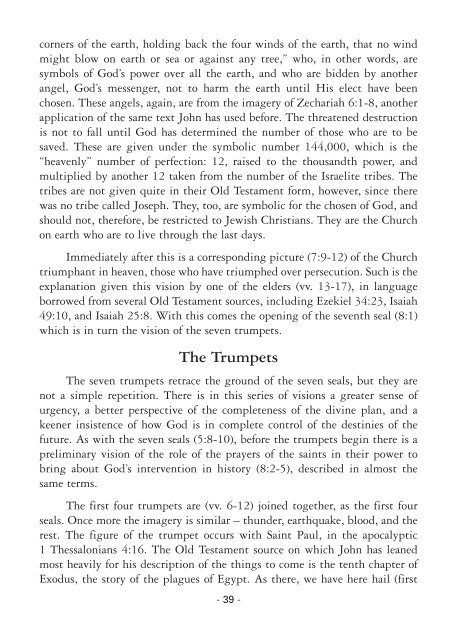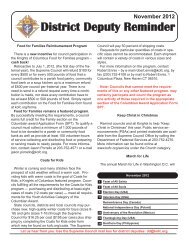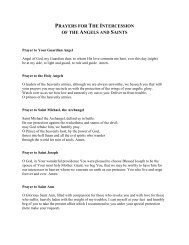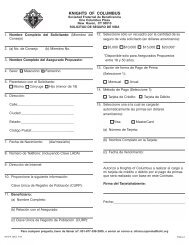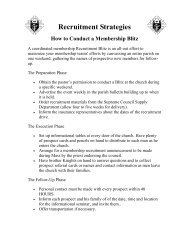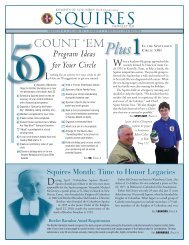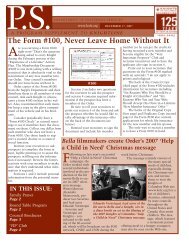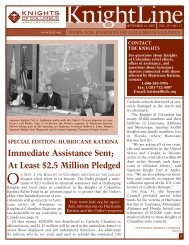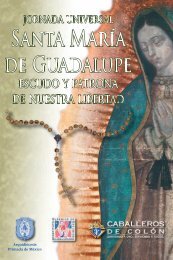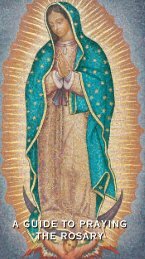Revelation: - Knights of Columbus, Supreme Council
Revelation: - Knights of Columbus, Supreme Council
Revelation: - Knights of Columbus, Supreme Council
You also want an ePaper? Increase the reach of your titles
YUMPU automatically turns print PDFs into web optimized ePapers that Google loves.
corners <strong>of</strong> the earth, holding back the four winds <strong>of</strong> the earth, that no wind<br />
might blow on earth or sea or against any tree,” who, in other words, are<br />
symbols <strong>of</strong> God’s power over all the earth, and who are bidden by another<br />
angel, God’s messenger, not to harm the earth until His elect have been<br />
chosen. These angels, again, are from the imagery <strong>of</strong> Zechariah 6:1-8, another<br />
application <strong>of</strong> the same text John has used before. The threatened destruction<br />
is not to fall until God has determined the number <strong>of</strong> those who are to be<br />
saved. These are given under the symbolic number 144,000, which is the<br />
“heavenly” number <strong>of</strong> perfection: 12, raised to the thousandth power, and<br />
multiplied by another 12 taken from the number <strong>of</strong> the Israelite tribes. The<br />
tribes are not given quite in their Old Testament form, however, since there<br />
was no tribe called Joseph. They, too, are symbolic for the chosen <strong>of</strong> God, and<br />
should not, therefore, be re stricted to Jewish Christians. They are the Church<br />
on earth who are to live through the last days.<br />
Immediately after this is a cor responding picture (7:9-12) <strong>of</strong> the Church<br />
triumphant in heaven, those who have triumphed over persecu tion. Such is the<br />
explanation given this vision by one <strong>of</strong> the elders (vv. 13-17), in language<br />
borrowed from several Old Testament sources, including Ezekiel 34:23, Isaiah<br />
49:10, and Isaiah 25:8. With this comes the opening <strong>of</strong> the seventh seal (8:1)<br />
which is in turn the vision <strong>of</strong> the seven trumpets.<br />
The Trumpets<br />
The seven trumpets retrace the ground <strong>of</strong> the seven seals, but they are<br />
not a simple repetition. There is in this series <strong>of</strong> visions a greater sense <strong>of</strong><br />
urgency, a better perspec tive <strong>of</strong> the completeness <strong>of</strong> the divine plan, and a<br />
keener insistence <strong>of</strong> how God is in complete control <strong>of</strong> the destinies <strong>of</strong> the<br />
future. As with the seven seals (5:8-10), be fore the trumpets begin there is a<br />
preliminary vision <strong>of</strong> the role <strong>of</strong> the prayers <strong>of</strong> the saints in their power to<br />
bring about God’s intervention in history (8:2-5), described in almost the<br />
same terms.<br />
The first four trumpets are (vv. 6-12) joined together, as the first four<br />
seals. Once more the imagery is similar – thunder, earth quake, blood, and the<br />
rest. The figure <strong>of</strong> the trumpet occurs with Saint Paul, in the apocalyptic<br />
1 Thessalonians 4:16. The Old Testament source on which John has leaned<br />
most heavily for his description <strong>of</strong> the things to come is the tenth chapter <strong>of</strong><br />
Exodus, the story <strong>of</strong> the plagues <strong>of</strong> Egypt. As there, we have here hail (first<br />
- 39 -


